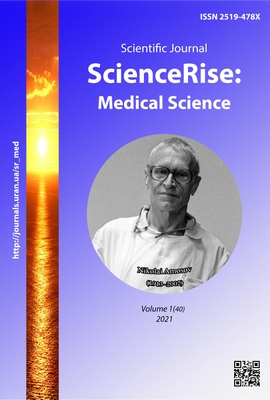The influence of solution choice on fluid resuscitation in patients with septic shock
DOI:
https://doi.org/10.15587/2519-4798.2021.224654Keywords:
sorbitol, balanced, crystalloid, Ringer's acetate, L-malonic acid, septic shock, monitoring, hemodynamics, safety, plateletsAbstract
The aim. Compare the hemodynamic effects and safety of infusion of the balanced crystalloid solution, sorbitol-based solution, and standard solution (0.9 % sodium chloride).
Materials and methods. A prospective randomized clinical trial was carried out, the study included 68 adult patients, who had the active surgical infection, and were in a state of septic shock. A corresponding solution with a volume of 500 ml was used for resuscitation. Hemodynamic and other clinical and laboratory parameters were monitored.
Results. There was no significant difference in mean arterial pressure (MAP) between the 3 groups before the 45th minute (p>0.05), from the 50th minute to 2 hours they were found only between the NS and Sorb groups (p <0.05). No statistically significant difference in heart rate (HR) was obtained in any measurement (p> 0.05). Cardiac output (CO) and oxygen delivery (DO2) did not differ until 35 min (p> 0.05) and up to 40 min (p> 0.05); after 40 min and 45 min, a significant difference was also found between the Sorb and NS groups (p <0.05). After infusion of a sorbitol-containing solution and a balanced polyionic solution, the acid-base state of the blood significantly improved. The applied dose of the sorbitol-containing solution was safe for renal function and blood clotting in septic shock in this study. But the applied balanced polyionic solution may be associated with a decrease in the number of platelets. Daily changes by APACHE II scores in each group were not statistically significant. The difference in 7-day and 28-day mortality between groups was not statistically significant (p>0.05).
Conclusions. In our study, the balanced polyionic solution with 1.9 % sodium lactate and 6 % sorbitol was the most effective and safe infusion solution for the treatment of septic shock, it can be used as a supplement to balanced crystalloid solutions. When using a balanced polyionic solution (Ringer's acetate) with 0.07 % L-malonic acid, the platelet count should be monitored more often
References
Rhodes, A., Evans, L. E., Alhazzani, W., Levy, M. M., Antonelli, M., Ferrer, R. et. al. (2017). Surviving Sepsis Campaign: International Guidelines for Management of Sepsis and Septic Shock: 2016. Intensive Care Medicine, 43 (3), 304–377. doi: http://doi.org/10.1007/s00134-017-4683-6
Simpson, N., Lamontagne, F., Shankar-Hari, M. (2017). Septic shock resuscitation in the first hour. Current Opinion in Critical Care, 23 (6), 561–566. doi: http://doi.org/10.1097/mcc.0000000000000460
Leisman, D., Wie, B., Doerfler, M., Bianculli, A., Ward, M. F., Akerman, M. et. al. (2016). Association of Fluid Resuscitation Initiation Within 30 Minutes of Severe Sepsis and Septic Shock Recognition With Reduced Mortality and Length of Stay. Annals of Emergency Medicine, 68 (3), 298–311. doi: http://doi.org/10.1016/j.annemergmed.2016.02.044
Cinel, I., Kasapoglu, U. S., Gul, F., Dellinger, R. P. (2020). The initial resuscitation of septic shock. Journal of Critical Care, 57, 108–117. doi: http://doi.org/10.1016/j.jcrc.2020.02.004
Tafner, P. F. do A., Chen, F. K., Rabello Filho, R., Corrêa, T. D., Chaves, R. C. de F., Serpa Neto, A. (2017). Recent advances in bedside microcirculation assessment in critically ill patients. Revista Brasileira de Terapia Intensiva, 29 (2), 238–247. doi: http://doi.org/10.5935/0103-507x.20170033
Nasirova, R. I., Fatullaeva, А. А. (2020). Optimization of infusion-transfusion therapy in patients with traumatic brain injury. Infusion & Chemotherapy, 3.1, 51–52. doi: http://doi.org/10.32902/2663-0338-2020-3.1-43
Cherniy, V. (2015). Topical aspects of infusion therapy. Emergency medicine, 3, 43–53.
Parrish, D., Lindell, S. L., Reichstetter, H., Aboutanos, M., Mangino, M. J. (2016). Cell Impermeant-based Low-volume Resuscitation in Hemorrhagic Shock: A Biological Basis for Injury Involving Cell Swelling. Annals of Surgery, 263 (3), 565–572. doi: http://doi.org/10.1097/sla.0000000000001049
Datsyuk, O. I. (2016). Optimization of Infusion Therapy in Preoperative Period in Patients with Acute Pancreatitis. Klinicheskaia Khirurgiia, 7, 8–10.
Konovchuk, V. M., Andrushchak, A. V. (2018). The effect of reosorbilact on volumetric and osmoregulatory renal functions in patients with dopamine-dependent compensation for sepsis-induced hypotension. Journal of Education, Health and Sport, 8 (2), 280–289. doi: http://doi.org/10.5281/zenodo.1186275
Gumeniuk, M. I., Gumeniuk, G. L., Opimakh, S. G. (2020). Anaphylactic shock infusion therapy. Infusion & Chemotherapy, 2, 21–27. doi: http://doi.org/10.32902/2663-0338-2020-2-21-27
Singer, M., Deutschman, C. S., Seymour, C. W., Shankar-Hari, M., Annane, D., Bauer, M. et. al. (2016). The Third International Consensus Definitions for Sepsis and Septic Shock (Sepsis-3). JAMA, 315 (8), 801–810. doi: http://doi.org/10.1001/jama.2016.0287
Nguyen, H. B., Jaehne, A. K., Jayaprakash, N., Semler, M. W., Hegab, S., Yataco, A. C. et. al. (2016). Early goal-directed therapy in severe sepsis and septic shock: insights and comparisons to ProCESS, ProMISe, and ARISE. Critical Care, 20 (1). doi: http://doi.org/10.1186/s13054-016-1288-3
Reddy, S. K., Bailey, M. J., Beasley, R. W., Bellomo, R., Mackle, D. M., Psirides, A. J., Young, P. J. (2017). Effect of 0.9 % Saline or Plasma-Lyte 148 as Crystalloid Fluid Therapy in the Intensive Care Unit on Blood Product Use and Postoperative Bleeding After Cardiac Surgery. Journal of Cardiothoracic and Vascular Anesthesia, 31 (5), 1630–1638. doi: http://doi.org/10.1053/j.jvca.2017.04.023
Downloads
Published
How to Cite
Issue
Section
License
Copyright (c) 2021 Тинлань Цзо, Сергей Александрович Солярик

This work is licensed under a Creative Commons Attribution 4.0 International License.
Our journal abides by the Creative Commons CC BY copyright rights and permissions for open access journals.
Authors, who are published in this journal, agree to the following conditions:
1. The authors reserve the right to authorship of the work and pass the first publication right of this work to the journal under the terms of a Creative Commons CC BY, which allows others to freely distribute the published research with the obligatory reference to the authors of the original work and the first publication of the work in this journal.
2. The authors have the right to conclude separate supplement agreements that relate to non-exclusive work distribution in the form in which it has been published by the journal (for example, to upload the work to the online storage of the journal or publish it as part of a monograph), provided that the reference to the first publication of the work in this journal is included.









